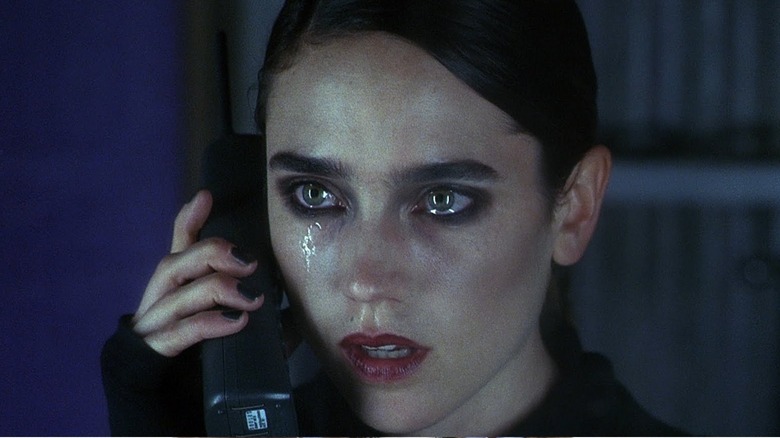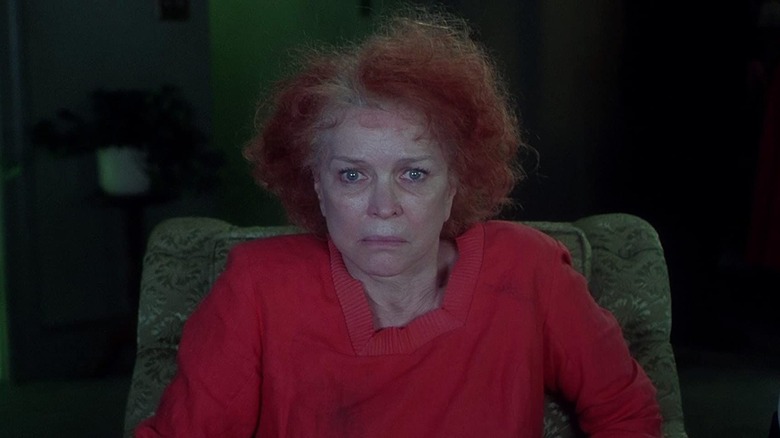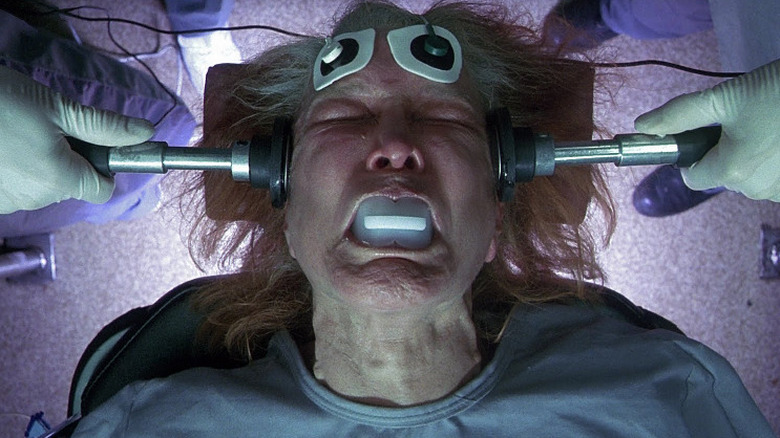Darren Aronofsky Made Requiem For A Dream All In Service Of A Single Scene
Darren Aronofsky's 2000 addiction drama "Requiem for a Dream" is an aggressively devastating, forthrightly tragic scare film that long lingers in the consciousness. Based on the 1978 novel by Hubert Selby, Jr., "Requiem" bears all the emotional beats of ignorant "druggie" films of the 1930s ("Reefer Madness" and the like) with the added benefit of hypnotic, brilliant, cinematic style. As each of the characters descends deeper and deeper into self ruin at the hands of their drug thirst, we share their pain, feel their desperation, understand their loss. The world is only briefly bright at the times when the drugs are freshly consumed. All other times are devoted to seeking the high again once it wears off. As William S. Burroughs once said: "A junky runs on junk time. When his junk is cut off, the clock runs down and stops. All he can do is hang on and wait for non-junk time to start. A sick junkie has no escape from external time, no place to go. He can only wait."
In a 2020 oral history of "Requiem" on Vulture, Aronofsky talked a lot about the Selby novel and how much it marked him when he read it for the first time as a college student. He talks about picking out Selby's "Last Exit to Brooklyn" — Brooklyn is Aronofsky's home town — and immediately becoming obsessed with the author, thrilled by his gift for storytelling. Aronofsky even credits Selby for him wanting to become a filmmaker. Indeed, when Aronofsky wanted to make short films for the first time, he called Selby to ask permission and was lucky enough to meet his hero. Selby, a very calm, poetic man to Aronofsky's recollection, said yes.
"Requiem for a Dream" would be Aronofsky's second feature.
The red dress monologue
In the oral history, Aronofsky describes Selby's novel as being cinematic, feeling it to be very visual and visceral. The novel is set in the Bronx, and Aronofsky asked Selby if he could transpose the action to Brooklyn, to shoot in a neighborhood he was more familiar with. Aronofsky was drawn to the novel in general, but admitted there was one scene in particular on which the entire film hinged: The red dress monologue.
The story of "Requiem for a Dream" follows Harry and Marion (Jared Leto and Jennifer Connelly) as they traverse the world while wresting with heroin addition. Harry's mother Sara (Ellen Burstyn) is concerned, but becomes distracted by an invitation to appear on her favorite game show. In order to fit into a red dress — the one she wore to her son's graduation — she attempts a crash diet and eventually turns to diet pills, which are merely methamphetamine tablets. She, too, soon becomes addicted, and spends the film slowly deteriorating. She and Harry have a sad conversation about it, and Aronofsky wanted the entire film to hinge on it. He said:
"For me, probably the reason I made the movie, was for that scene. The 'red dress monologue,' in which Harry visits his mother and realizes she is on uppers, is the devastating heart of the movie. Sara confesses that she hasn't had anything to live for besides her impending TV appearance, and from this point on, increases her dosage. It broke my heart every time I read it. I knew that that was the center of the film — if it was a seesaw, this was the fulcrum."
A soft image that Kurosawa would approve of
When it came to shooting the scene in question, Aronofsky expressed some trepidation, concerned how he would be able to make a scene of two people sitting at a kitchen table in a small Brooklyn apartment look dynamic or interesting. Luckily for the director, Burstyn provided such a striking, intense, sad performance, any kind of additional visual dynamism wasn't necessary. Burstyn was so good, in fact, the take was nearly ruined by cinematographer Matthew Libatique. As Aronofsky tells it:
"I can't say I remember how Ellen got there, but something triggered for her in that sequence that was just remarkable. We all sat there in awe watching her do a take, and we were all teary-eyed at the end. And [Libatique], it turns out, had fogged up the viewfinder because he was crying. And when it came back, the shot was just the tiniest bit soft. I was devastated."
Luckily, Aronofsky — perhaps to give himself a little bit of a creative boost — just so happened to see something very similar happening in Japanese classic from the 1950s. Asakazu Nakai, who shot multiple films for Akira Kurosawa (including "Throne of Blood" and "Red Beard"), once made a creative decision on "Seven Samurai" that gave Aronofsky validation:
"Then I was watching 'Seven Samurai,' because sometimes I'll watch my favorite films while working on a movie. There's this amazing breakdown by Toshiro Mifune in the movie, and it's actually soft. I was like, 'Okay. Good enough for Kurosawa, it's definitely good enough for me.'"
While other scenes in "Requiem" stand out for their rawness and darkness, Aronofsky is right in seeing the red dress monologue as the fulcrum of the film. It rips your heart out.
And it looks amazing.


